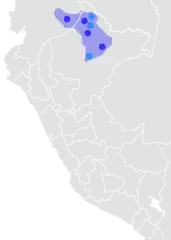| Kody rodziny językowej | |
|---|---|
| Glottolog | zapa1251 |
| Występowanie | |
 Występowanie języków zaparo w Ameryce Południowej | |
| Ta strona zawiera symbole fonetyczne MAF. Bez właściwego wsparcia renderowania wyświetlane mogą być puste prostokąty lub inne symbole zamiast znaków Unicode. | |
Języki zaparo lub zaparońskie (sáparo, sáparoan, záparo, zaparoano, zaparoana) – rodzina języków południowoamerykańskich używanych przez Indian Záparo, mieszkających na terenie Peru i Ekwadoru[1]. Większość tych języków jest wymarłych, a pozostałe są na skraju wymarcia[2]. Należy tu 7 języków[3].
Klasyfikacja
- fyla andyjska
- makrorodzina hipotetyczna – języki zaparo-jaguańskie
- rodzina – zaparońska
- grupa zaparo
- język záparo [zro][uwaga 1] – język prawie wymarły, 5 użytkowników (2007)[4]
- język arabela [arl] – język wymierający: 50 użytkowników (2002)[5]
- język andoa [anb] – język wymarły, † (1993)[6]
- grupa iquito-cahuarano
- język ausziri – język wymarły, †[3]
- język iquito [iqu] – język wymierający: 35 użytkowników (2002)[7]
- język cahuarano [cah] – język wymarły, † (2002)[8]
- niesklasyfikowane
- język omurano [omu] – język wymarły, † (1958)[9][3]
- grupa zaparo
- rodzina – zaparońska
| Grupy i języki | Liczba mówiących | Kraje |
|---|---|---|
| Języki iquito-cahuarano | ||
| cahuarano (kauarano, cziripuno) | 0 | Peru |
| iquito (ikito, amakakore, puka-uma) | 35 | Peru |
| ausziri | 0 | Peru |
| Języki zaparońskie (zaparo) właściwe | ||
| zaparo (kayapwe, sapara) | 5 | Ekwador |
| Języki arabela-andoa | ||
| andoa (gae, gaye) | 0 | Peru |
| arabela (cziripuno) | 50 | Peru |
Uwagi
Przypisy
- ↑ Summary by language family. W: Lewis, M. Paul, Gary F. Simons, Charles D. Fennig: Ethnologue: Languages of the World, Seventeenth edition. Dallas, Texas: SIL International, 2014.
- ↑ Lyle Campbell, Verónica Grondona: The Indigenous Languages of South America: A Comprehensive Guide. Walter de Gruyter, 2012, s. 211. ISBN 978-3-11-025803-5. [dostęp 2014-11-29].
- 1 2 3 International Encyclopedia of Linguistics: AAVE – Esperanto, Volume 1. Oxford University Press, 2003, s. 411. ISBN 978-0-19-513977-8. [dostęp 2014-11-29].
- ↑ M. Paul Lewis, Gary F. Simons, Charles D. Fennig (red.), Záparo, [w:] Ethnologue: Languages of the World, wyd. 17, Dallas: SIL International, 2013–2014 [dostęp 2012-11-30] (ang.).
- ↑ M. Paul Lewis, Gary F. Simons, Charles D. Fennig (red.), Omurano, [w:] Ethnologue: Languages of the World, wyd. 17, Dallas: SIL International, 2013–2014 [dostęp 2012-11-30] (ang.).
- ↑ M. Paul Lewis, Gary F. Simons, Charles D. Fennig (red.), Andoa, [w:] Ethnologue: Languages of the World, wyd. 17, Dallas: SIL International, 2013–2014 [dostęp 2012-11-30] (ang.).
- ↑ M. Paul Lewis, Gary F. Simons, Charles D. Fennig (red.), Iquito, [w:] Ethnologue: Languages of the World, wyd. 17, Dallas: SIL International, 2013–2014 [dostęp 2012-11-30] (ang.).
- ↑ M. Paul Lewis, Gary F. Simons, Charles D. Fennig (red.), Cahuarano, [w:] Ethnologue: Languages of the World, wyd. 17, Dallas: SIL International, 2013–2014 [dostęp 2012-11-30] (ang.).
- ↑ M. Paul Lewis, Gary F. Simons, Charles D. Fennig (red.), Omurano, [w:] Ethnologue: Languages of the World, wyd. 17, Dallas: SIL International, 2013–2014 [dostęp 2012-11-30] (ang.).
Linki zewnętrzne
- Hammarström, Harald & Forkel, Robert & Haspelmath, Martin & Nordhoff, Sebastian. 2014. Glottolog 2.3.: Family: Zaparoan. Leipzig: Max Planck Institute for Evolutionary Anthropology. [dostęp 2014-11-29]. (ang.).
This article is issued from Wikipedia. The text is licensed under Creative Commons - Attribution - Sharealike. Additional terms may apply for the media files.